Titanium Versus Bioabsorbable Magnesium Headless Compression Screw Fixation for Tibial Tubercle Osteotomy
Abstract
1. Introduction
2. Materials and Methods
2.1. Patients, Study Design, and Sample Size Calculation
2.2. Surgical Technique and Implants
2.3. Postoperative Rehabilitation and Follow-Up
2.4. Radiological Evaluation
2.5. Assessment of Functional Outcomes and Complications
2.6. Statistical Analysis
3. Results
Radiographic Findings in the Mg Screw Group
4. Discussion
5. Conclusions
Author Contributions
Funding
Institutional Review Board Statement
Informed Consent Statement
Data Availability Statement
Conflicts of Interest
Abbreviations
| AHPLT | Anterior Half of the Peroneus Longus Tendon |
| ASA | American Society of Anesthesiologists |
| CT | Computed Tomography |
| MRI | Magnetic Resonance Imaging |
| MPFL | Medial Patellofemoral Ligament |
| MPFLR | Medial Patellofemoral Ligament Reconstruction |
| Mg | Magnesium |
| ROM | Range of Motion |
| SD | Standard Deviation |
| Ti | Titanium |
| TT | Tibial Tubercle |
| TG | Trochlear Groove |
References
- Stokes, D.J.; Elrick, B.P.; Carpenter, M.L.; Raji, Y.; McQuivey, K.S.; Sherman, S.L.; Frank, R.M. Tibial Tubercle Osteotomy: Indications, Outcomes, and Complications. Curr. Rev. Musculoskelet. Med. 2024, 17, 484–495. [Google Scholar] [CrossRef] [PubMed]
- Bernstein, M.; Bozzo, I.; Patrick Park, J.; Pauyo, T. Patellofemoral Instability Part II: Surgical Treatment. J. Am. Acad. Orthop. Surg. 2024, 32, e1035–e1046. [Google Scholar] [CrossRef]
- Ricciuti, A.; Colosi, K.; Fitzsimmons, K.; Brown, M. Patellofemoral Instability in the Pediatric and Adolescent Population: From Causes to Treatments. Children 2024, 11, 1261. [Google Scholar] [CrossRef]
- Aykanat, F.; Kose, O.; Guneri, B.; Celik, H.K.; Cakar, A.; Tasatan, E.; Ulmeanu, M.E. Comparison of four different screw configurations for the fixation of Fulkerson osteotomy: A finite element analysis. J. Orthop. Traumatol. 2023, 24, 30. [Google Scholar] [CrossRef]
- Guneri, B.; Kose, O.; Celik, H.K.; Cakar, A.; Tasatan, E.; Rennie, A.E.W. How to fix a tibial tubercle osteotomy with distalisation: A finite element analysis. Knee 2022, 37, 132–142. [Google Scholar] [CrossRef]
- Davis, K.; Caldwell, P.; Wayne, J.; Jiranek, W.A. Mechanical comparison of fixation techniques for the tibial tubercle osteotomy. Clin. Orthop. Relat. Res. 2000, 380, 241–249. [Google Scholar] [CrossRef]
- DeNovio, A.C.; Holle, A.; Pan, X.; Saris, D.B.F.; Krych, A.J.; Hevesi, M.; Okoroha, K.; Tagliero, A.J. Incidence of Complications, Recurrent Instability, and All-Cause Reoperations After Tibial Tubercle Osteotomy for Patellofemoral Instability: A Systematic Review and Meta-analysis of the Literature. Orthop. J. Sports Med. 2025, 13, 23259671251374307. [Google Scholar] [CrossRef]
- Davis, M.; Meta, F.; Dancy, M.E.; Scott, P.A.; Pan, X.; Tagliero, A.J.; Krych, A.J.; Hevesi, M.; Okoroha, K.R. Pain and Hardware Removal After Tibial Tubercle Osteotomy: Incidence, Associated Factors, and Outcomes. Orthop. J. Sports Med. 2025, 13, 23259671251324481. [Google Scholar] [CrossRef] [PubMed]
- Payne, J.; Rimmke, N.; Schmitt, L.C.; Flanigan, D.C.; Magnussen, R.A. The Incidence of Complications of Tibial Tubercle Osteotomy: A Systematic Review. Arthroscopy 2015, 31, 1819–1825. [Google Scholar] [CrossRef] [PubMed]
- Tecklenburg, K.; Feller, J.A.; Whitehead, T.S.; Webster, K.E.; Elzarka, A. Outcome of surgery for recurrent patellar dislocation based on the distance of the tibial tuberosity to the trochlear groove. J. Bone Jt. Surg. Br. 2010, 92, 1376–1380. [Google Scholar] [CrossRef]
- Plaass, C.; Ettinger, S.; Sonnow, L.; Koenneker, S.; Noll, Y.; Weizbauer, A.; Reifenrath, J.; Claassen, L.; Daniilidis, K.; Stukenborg-Colsman, C.; et al. Early results using a biodegradable magnesium screw for modified chevron osteotomies. J. Orthop. Res. 2016, 34, 2207–2214. [Google Scholar] [CrossRef] [PubMed]
- Herber, V.; Labmayr, V.; Sommer, N.G.; Marek, R.; Wittig, U.; Leithner, A.; Seibert, F.; Holweg, P. Can Hardware Removal be Avoided Using Bioresorbable Mg-Zn-Ca Screws After Medial Malleolar Fracture Fixation? Mid-Term Results of a First-In-Human Study. Injury 2022, 53, 1283–1288. [Google Scholar] [CrossRef]
- Kose, O.; Turan, A.; Unal, M.; Acar, B.; Guler, F. Fixation of medial malleolar fractures with magnesium bioabsorbable headless compression screws: Short-term clinical and radiological outcomes in eleven patients. Arch. Orthop. Trauma Surg. 2018, 138, 1069–1075. [Google Scholar] [CrossRef]
- Zhao, D.W.; Zhang, T.W.; Wang, W.D.; Wang, Z.M.; Wang, F.Y.; Yang, X.; Li, R.H.; Cheng, L.L.; Zhang, Y.; Wang, H.Y.; et al. Internal fixation with biodegradable high purity magnesium screws in the treatment of ankle fracture. J. Orthop. Transl. 2025, 51, 198–206. [Google Scholar] [CrossRef]
- May, H.; Alper Kati, Y.; Gumussuyu, G.; Yunus Emre, T.; Unal, M.; Kose, O. Bioabsorbable magnesium screw versus conventional titanium screw fixation for medial malleolar fractures. J. Orthop. Traumatol. 2020, 21, 9. [Google Scholar] [CrossRef]
- Acar, B.; Kose, O.; Unal, M.; Turan, A.; Kati, Y.A.; Guler, F. Comparison of magnesium versus titanium screw fixation for biplane chevron medial malleolar osteotomy in the treatment of osteochondral lesions of the talus. Eur. J. Orthop. Surg. Traumatol. 2020, 30, 163–173. [Google Scholar] [CrossRef]
- Acar, B.; Unal, M.; Turan, A.; Kose, O. Isolated Lateral Malleolar Fracture Treated with a Bioabsorbable Magnesium Compression Screw. Cureus 2018, 10, e2539. [Google Scholar] [CrossRef]
- Turan, A.; Kati, Y.A.; Acar, B.; Kose, O. Magnesium Bioabsorbable Screw Fixation of Radial Styloid Fractures: Case Report. J. Wrist Surg. 2020, 9, 150–155. [Google Scholar] [CrossRef] [PubMed]
- Stürznickel, J.; Delsmann, M.M.; Jungesblut, O.D.; Stücker, R.; Knorr, C.; Rolvien, T.; Kertai, M.; Rupprecht, M. Safety and performance of biodegradable magnesium-based implants in children and adolescents. Injury 2021, 52, 2265–2271. [Google Scholar] [CrossRef]
- Ünal, M.; Demirayak, E.; Ertan, M.B.; Kilicaslan, O.F.; Kose, O. Bioabsorbable magnesium screw fixation for tibial tubercle osteotomy; a preliminary study. Acta Biomed. 2022, 92, e2021263. [Google Scholar] [CrossRef]
- Faul, F.; Erdfelder, E.; Lang, A.G.; Buchner, A. G*Power 3: A flexible statistical power analysis program for the social, behavioral, and biomedical sciences. Behav. Res. Methods 2007, 39, 175–191. [Google Scholar] [CrossRef]
- Luhmann, S.J.; Fuhrhop, S.; O’Donnell, J.C.; Gordon, J.E. Tibial fractures after tibial tubercle osteotomies for patellar instability: A comparison of three osteotomy configurations. J. Child. Orthop. 2011, 5, 19–26. [Google Scholar] [CrossRef] [PubMed]
- Schöttle, P.B.; Schmeling, A.; Rosenstiel, N.; Weiler, A. Radiographic landmarks for femoral tunnel placement in medial patellofemoral ligament reconstruction. Am. J. Sports Med. 2007, 35, 801–804. [Google Scholar] [CrossRef] [PubMed]
- Morgan, C.; Bell, R.M.; Burland, J.P.; Kriscenski, D.; Ilinski, A.; Cote, M.P.; Edgar, C.M. Effectiveness of an Accelerated Rehabilitation Protocol After Tibial Tubercle Osteotomy. Orthop. J. Sports Med. 2022, 10, 23259671221133105. [Google Scholar] [CrossRef]
- Kujala, U.M.; Jaakkola, L.H.; Koskinen, S.K.; Taimela, S.; Hurme, M.; Nelimarkka, O. Scoring of patellofemoral disorders. Arthroscopy 1993, 9, 159–163. [Google Scholar] [CrossRef] [PubMed]
- Tegner, Y.; Lysholm, J. Rating systems in the evaluation of knee ligament injuries. Clin. Orthop. Relat. Res. 1985, 198, 43–49. [Google Scholar] [CrossRef]
- Quinn, J.V.; Drzewiecki, A.E.; Stiell, I.G.; Elmslie, T.J. Appearance scales to measure cosmetic outcomes of healed lacerations. Am. J. Emerg. Med. 1995, 13, 229–231. [Google Scholar] [CrossRef]
- Sukotjo, C.; Lima-Neto, T.J.; Santiago Júnior, J.F.; Faverani, L.P.; Miloro, M. Is There a Role for Absorbable Metals in Surgery? A Systematic Review and Meta-Analysis of Mg/Mg Alloy Based Implants. Materials 2020, 13, 3914. [Google Scholar] [CrossRef]
- Wang, J.L.; Xu, J.K.; Hopkins, C.; Chow, D.H.; Qin, L. Biodegradable Magnesium-Based Implants in Orthopedics-A General Review and Perspectives. Adv. Sci. 2020, 7, 1902443. [Google Scholar] [CrossRef]
- Haslhofer, D.J.; Gotterbarm, T.; Klasan, A. High Complication Rate and High Percentage of Regressing Radiolucency in Magnesium Screw Fixation in 18 Consecutive Patients. J. Pers. Med. 2023, 13, 357. [Google Scholar] [CrossRef]
- Lehane, K.; Wolfe, I.; Buseck, A.; Moore, M.R.; Chen, L.; Strauss, E.J.; Jazrawi, L.M.; Golant, A. Predictors of Increased Complication Rate Following Tibial Tubercle Osteotomy (TTO). Knee 2025, 53, 93–102. [Google Scholar] [CrossRef] [PubMed]
- Juutilainen, T.; Pätiälä, H.; Ruuskanen, M.; Rokkanen, P. Comparison of costs in ankle fractures treated with absorbable or metallic fixation devices. Arch. Orthop. Trauma Surg. 1997, 116, 204–208. [Google Scholar] [CrossRef] [PubMed]
- Böstman, O.M. Metallic or absorbable fracture fixation devices: A cost minimization analysis. Clin. Orthop. Relat. Res. 1996, 329, 233–239. [Google Scholar] [CrossRef]
- Klauser, H. Internal fixation of three-dimensional distal metatarsal I osteotomies in the treatment of hallux valgus deformities using biodegradable magnesium screws in comparison to titanium screws. Foot Ankle Surg. 2019, 25, 398–405. [Google Scholar] [CrossRef] [PubMed]
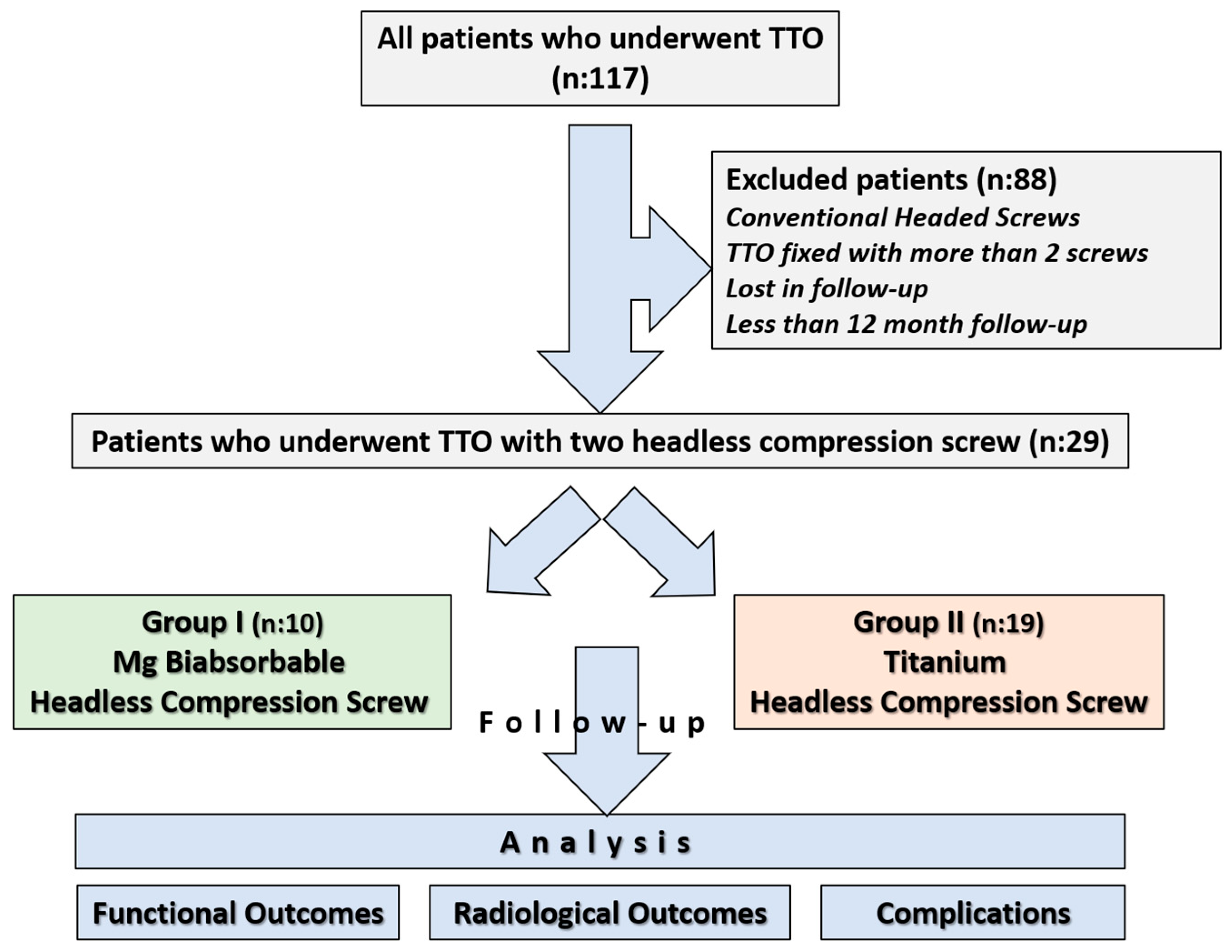
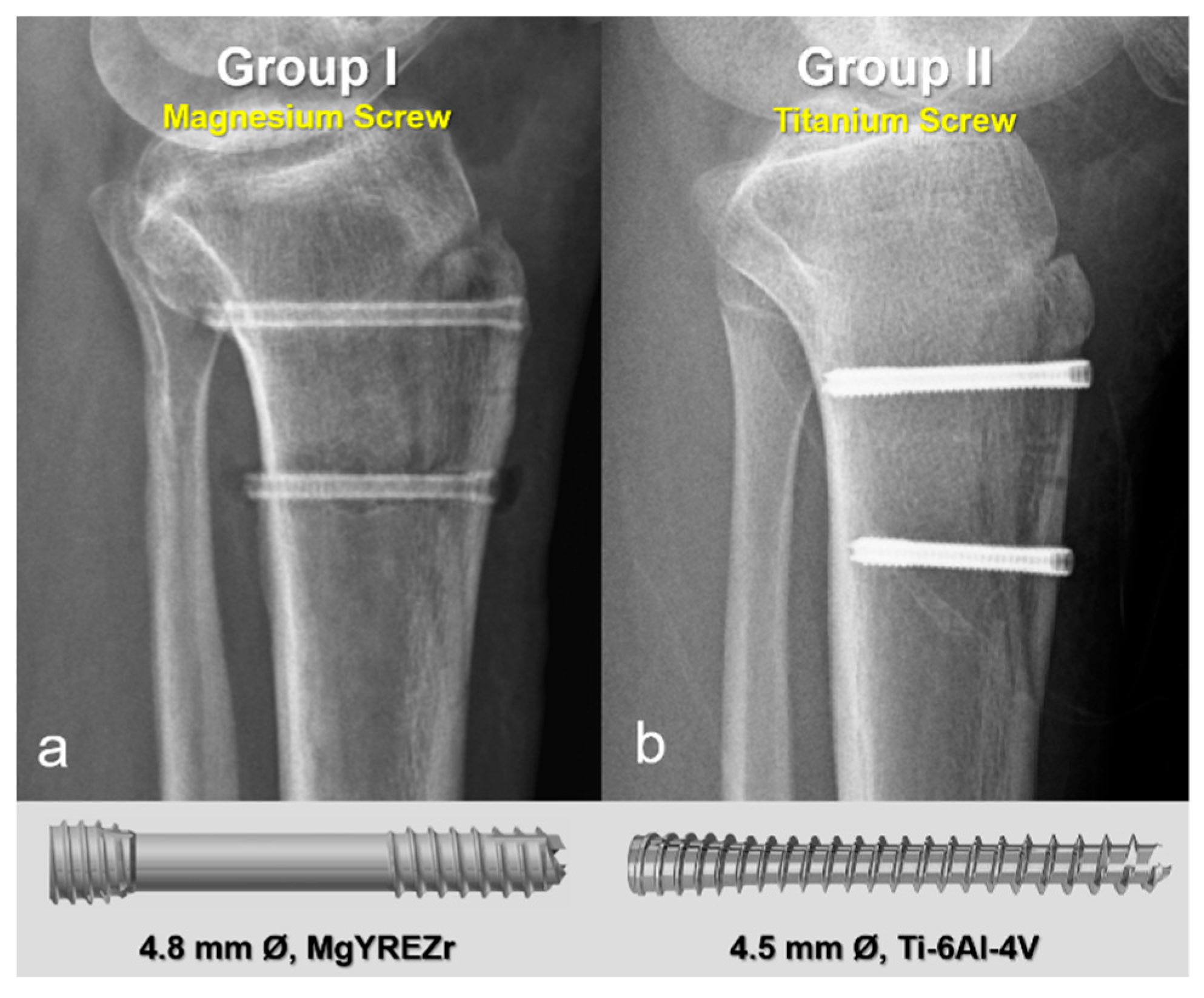
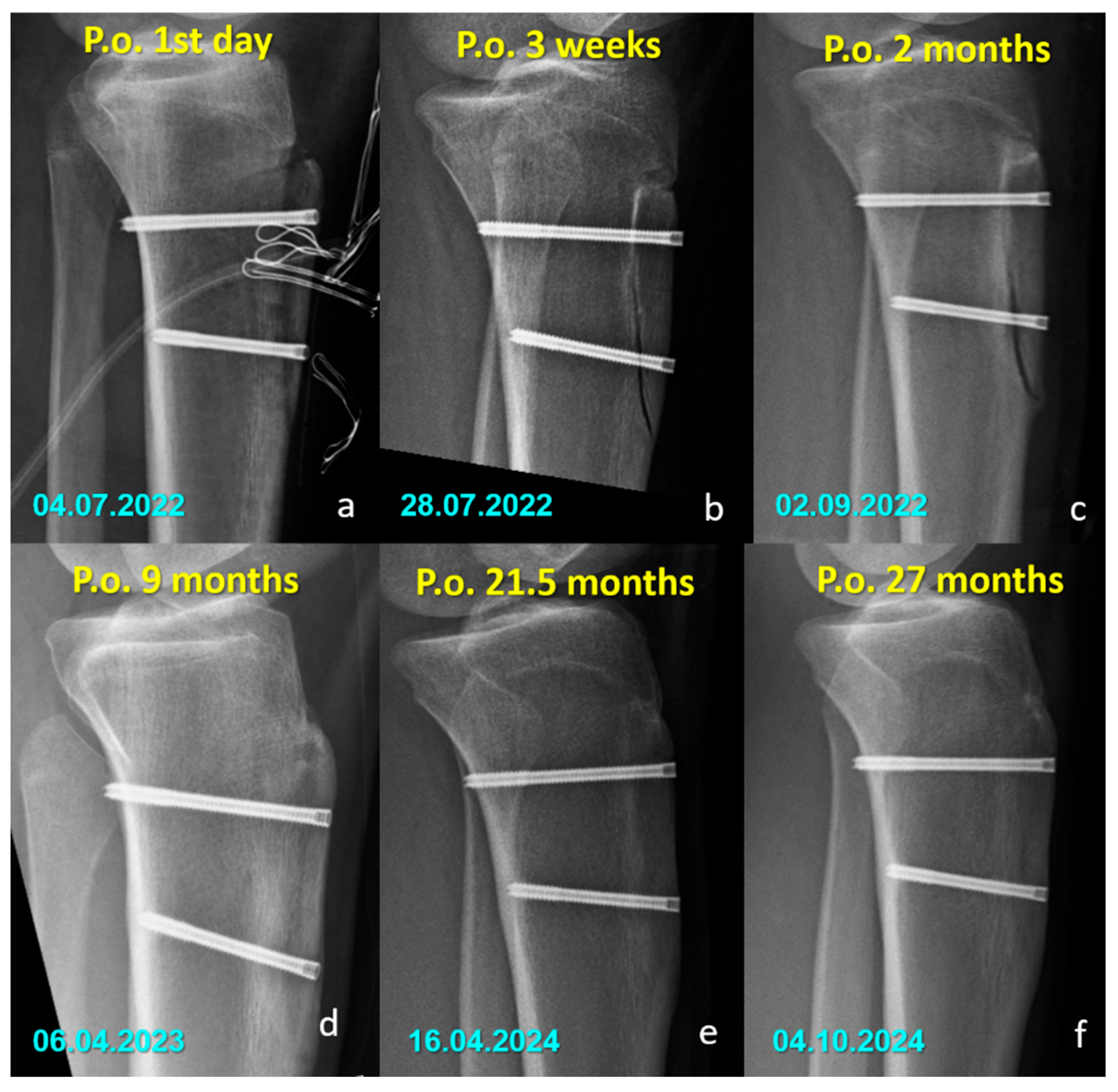
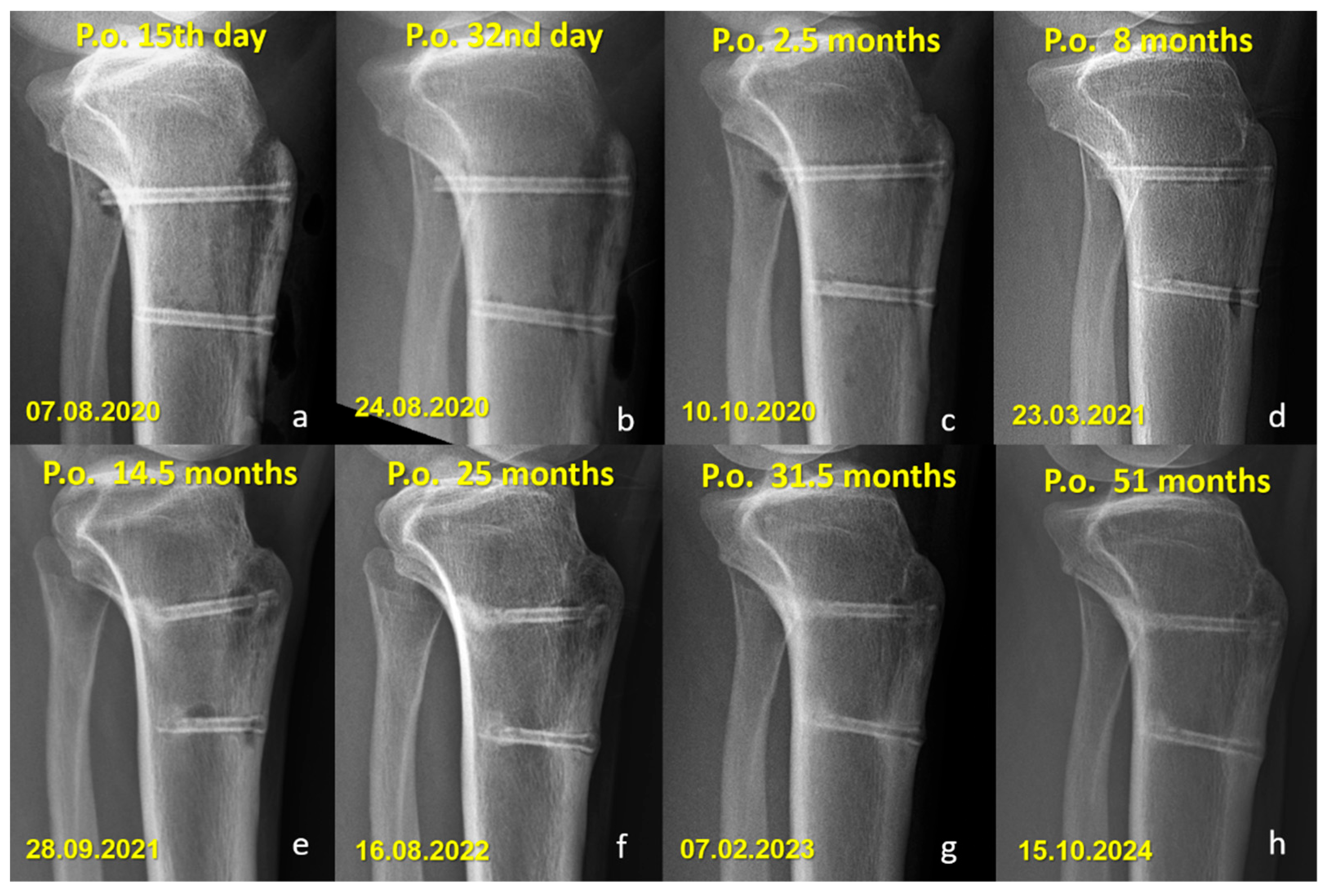
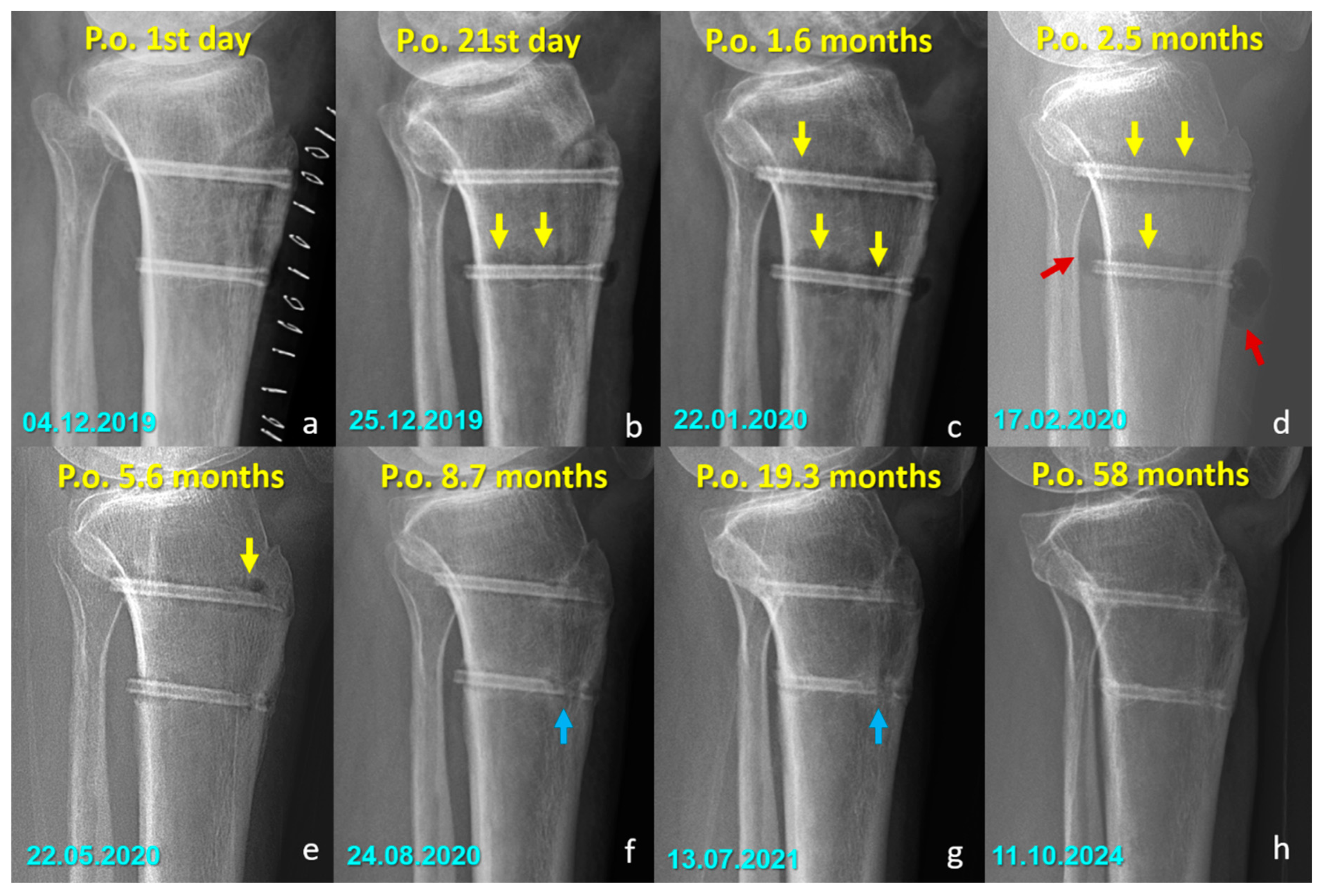
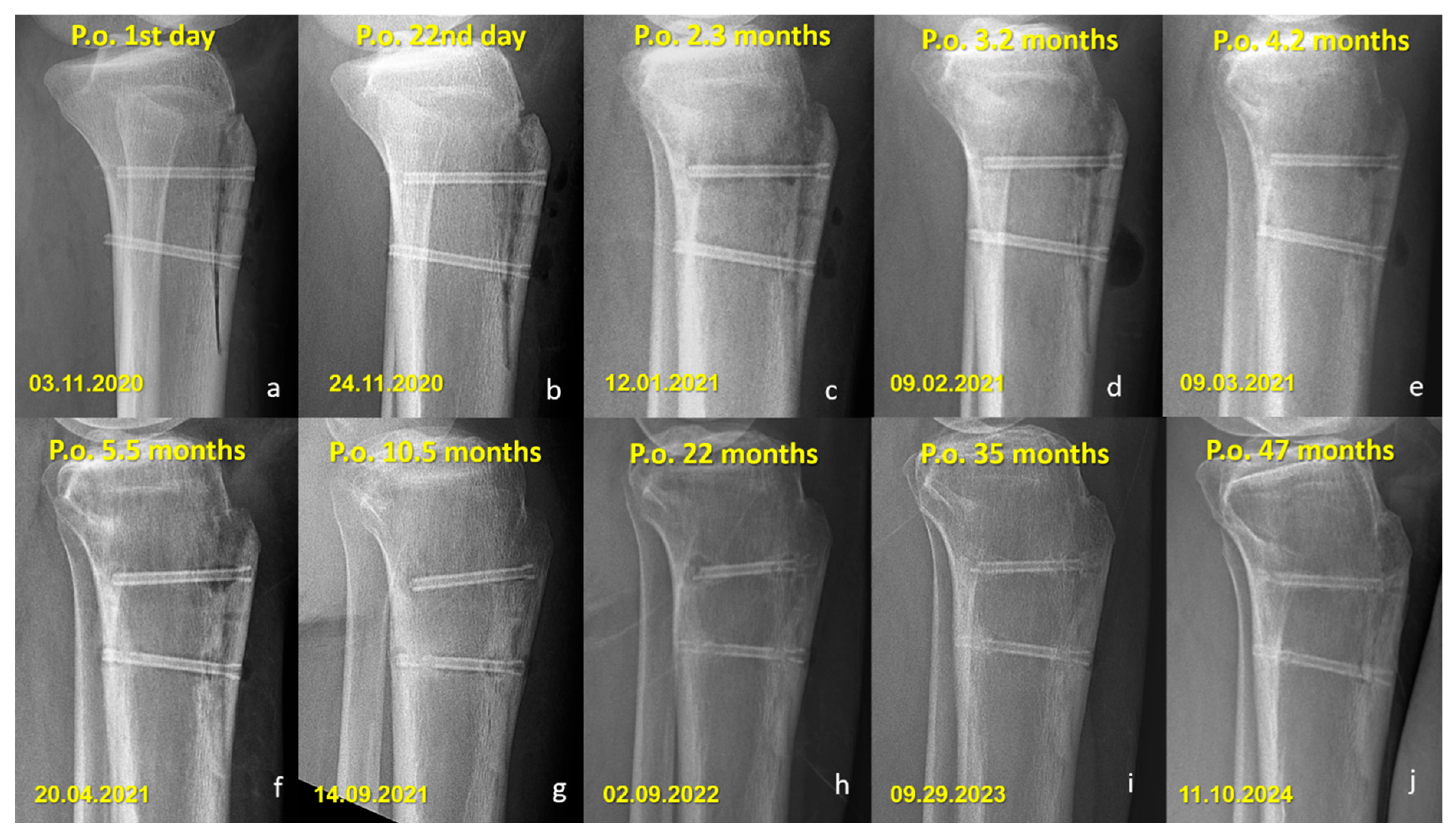
| Variables | Mg Group (n:10) | Ti Group (n:19) | p-Value |
|---|---|---|---|
| Age (years ± SD) | 23.4 ± 9.2 | 19.7 ± 5.8 | 0.247 1 |
| Median (Range) | 20 (15–45) | 17 (12–30) | |
| Sex (n, %) | 0.283 2 | ||
| Male | 5 (50%) | 6 (32.6%) | |
| Female | 5 (50%) | 13 (68.4%) | |
| Side (n, %) | 0.636 2 | ||
| Right | 3 (30%) | 6 (32.6%) | |
| Left | 7 (70%) | 13 (68.4%) | |
| Weight (kg ± SD) | 171.9 ± 9.7 | 164.5 ± 9.5 | 0.060 3 |
| Height (cm ± SD) | 72.4 ± 14.6 | 62.6 ± 13.2 | 0.082 3 |
| BMI (kg/m2 ± SD) | 24.5 ± 5.2 | 23.1 ± 4.0 | 0.430 3 |
| ASA Score | 0.364 2 | ||
| ASA I | 6 (60%) | 14 (73.7%) | |
| ASA II | 4 (40%) | 5 (26.3%) | |
| Tobacco use (n, %) | 2 (20%) | 3 (15.8%) | 0.576 2 |
| Diabetes Mellitus | 1 (10%) | 0 (0%) | 0.345 2 |
| Acute vs. Recurrent (n, %) | 0.385 2 | ||
| Acute | 5 (50%) | 7 (36.8%) | |
| Recurrent | 5 (50%) | 12 (63.2%) | |
| TT-TG (mm ± SD) | 20.4 ± 3.2 | 20.4 ± 3.2 | 0.558 1 |
| Patellar Tilt (° ± SD) | 27.9 ± 8.7 | 27.9 ± 10.0 | 0.991 3 |
| Caton-Deschamps Index (ratio ± SD) | 1.02 ± 0.1 | 1.16 ± 0.1 | 0.008 3 |
| Patella Alta (n, %) | 1 (10%) | 3 (15.8%) | 0.571 2 |
| Dejour Classification (n, %) | 0.291 2 | ||
| Type A | 5 (50%) | 8 (42.1%) | |
| Type B | 5 (50%) | 7 (36.8%) | |
| Type C | 0 | 3 (15.8%) | |
| Type D | 0 | 1 (5.3%) | |
| Lower Limb Alignment | 0.555 2 | ||
| Normal | 6 (60%) | 15 (78.9%) | |
| Varus | 2 (20%) | 2 (10.5%) | |
| Valgus | 2 (20%) | 2 (10.5%) |
| Variables | Mg Group (n:10) | Ti Group (n:19) | p-Value |
|---|---|---|---|
| Osteotomy Length (cm ± SD) | 8.9 ± 1.3 | 7.1 ± 1.8 | 0.179 1 |
| Median (range) | 7.8 (6.6–11.1) | 7.4 (6.4–9.1) | |
| Concomitant Procedures | |||
| MPFLR | 9 (90%) | 19 (100%) | 0.345 2 |
| Lateral Capsular Lengthening | 0 (0%) | 2 (10.5%) | 0.421 2 |
| OCF Fixation | 2 (20%) | 2 (10.5) | 0.429 2 |
| OCF Removal | 1 (10%) | 1 (5.3%) | 0.579 2 |
| Graft option for MPFLR | 0.655 2 | ||
| Hamstring tendons | 9 (100%) | 18 (94.7%) | |
| AHPLT | 0 (0%) | 1 (5.3%) | |
| Single vs. Double Bundle MPLR | 0.548 2 | ||
| Single Bundle | 8 (88.9%) | 18 (94.7%) | |
| Double Bundle | 1 (11.1%) | 1 (5.3%) | |
| Duration of Operation (min ± SD) | 101.5 ± 14.3 | 93.1 ± 11.0 | 0.093 3 |
| Type of Anesthesia | 0.429 2 | ||
| Spinal | 8 (80%) | 17 (89.5%) | |
| General | 2 (20%) | 2 (10.5%) | |
| Length of Stay (days ± SD) | 1.6 ± 0.6 | 1.3 ± 0.6 | 0.377 1 |
| Median (range) | 1.5 (1–3) | 1 (1–3) |
| Variables | Mg Group (n:10) | Ti Group (n:19) | p-Value |
|---|---|---|---|
| Radiological Follow-up (months ± SD) | 47.9 ± 14.8 | 20.1 ± 6.1 | 0.001 1 |
| Median (range) | 50 (12–62) | 19 (12–31) | |
| Clinical Follow-up (months ± SD) | 56.7 ± 4.4 | 25.8 ± 6.7 | 0.001 1 |
| Median (range) | 58(47–62) | 25 (13–36) | |
| Kujala Score (point ± SD) | |||
| Preoperative | 47.9 ± 18.9 | 53.7 ± 22.4 | 0.456 1 |
| Postoperative | 93.3 ± 9.4 | 94.8 ± 8.2 | 0.668 1 |
| p-value | 0.005 2 | 0.001 2 | |
| LKS (point ± SD) | |||
| Preoperative | 55.9 ± 22.5 | 58.7 ± 17.4 | 0.946 1 |
| Postoperative | 95.0 ± 5.1 | 96.4 ± 4.6 | 0.484 1 |
| p-value | 0.005 2 | 0.001 2 | |
| Overall Satisfaction (point ± SD) | 9.6 ± 0.9 | 9.2 ± 0.9 | 0.266 1 |
| Cosmetic Satisfaction (point ± SD) | 8.2 ± 1.9 | 8.0 ± 1.8 | 0.735 1 |
| Postoperative Extension Deficit (n, %) | 0% | 0% | NA |
| Postoperative Flexion Deficit (n, %) | 0% | 0% | NA |
| Postoperative Muscle Strength Deficit (n, %) | 0% | 0% | NA |
| Postoperative Apprehension test (n, %) | 0% | 0% | NA |
| Postoperative Positive J-sign (n, %) | 1 (10%) | 1 (5.3%) | 0.579 3 |
| Hypoesthesia around the lower leg (n, %) | 4 (40%) | 10 (52.6%) | 0.400 3 |
| Implant removal (n, %) | 0% | 0% | NA |
Disclaimer/Publisher’s Note: The statements, opinions and data contained in all publications are solely those of the individual author(s) and contributor(s) and not of MDPI and/or the editor(s). MDPI and/or the editor(s) disclaim responsibility for any injury to people or property resulting from any ideas, methods, instructions or products referred to in the content. |
© 2025 by the authors. Licensee MDPI, Basel, Switzerland. This article is an open access article distributed under the terms and conditions of the Creative Commons Attribution (CC BY) license (https://creativecommons.org/licenses/by/4.0/).
Share and Cite
Ertan, M.B.; Uslu, O.; Dogruoz, F.; Celik, O.F.; Kose, O. Titanium Versus Bioabsorbable Magnesium Headless Compression Screw Fixation for Tibial Tubercle Osteotomy. J. Funct. Biomater. 2025, 16, 404. https://doi.org/10.3390/jfb16110404
Ertan MB, Uslu O, Dogruoz F, Celik OF, Kose O. Titanium Versus Bioabsorbable Magnesium Headless Compression Screw Fixation for Tibial Tubercle Osteotomy. Journal of Functional Biomaterials. 2025; 16(11):404. https://doi.org/10.3390/jfb16110404
Chicago/Turabian StyleErtan, Mehmet Baris, Oguzhan Uslu, Firat Dogruoz, Omer Faruk Celik, and Ozkan Kose. 2025. "Titanium Versus Bioabsorbable Magnesium Headless Compression Screw Fixation for Tibial Tubercle Osteotomy" Journal of Functional Biomaterials 16, no. 11: 404. https://doi.org/10.3390/jfb16110404
APA StyleErtan, M. B., Uslu, O., Dogruoz, F., Celik, O. F., & Kose, O. (2025). Titanium Versus Bioabsorbable Magnesium Headless Compression Screw Fixation for Tibial Tubercle Osteotomy. Journal of Functional Biomaterials, 16(11), 404. https://doi.org/10.3390/jfb16110404






